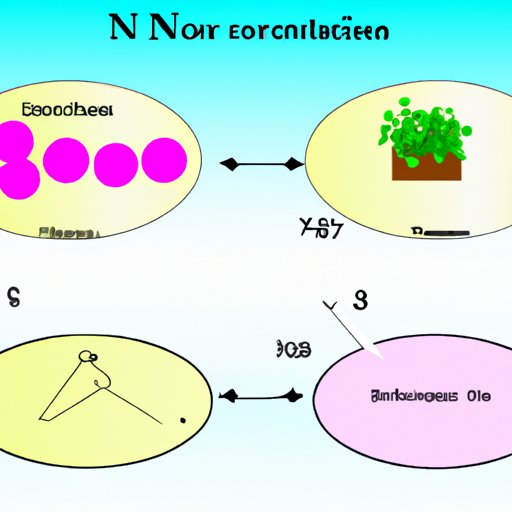Introduction
Nitrogen is an essential element for plant growth, as it helps support the development of healthy roots, leaves, stems, and flowers. In order to thrive, plants need access to a steady supply of nitrogen from natural or synthetic sources. This article will explore how nitrogen gets into plants and the role it plays in supporting their growth.

Exploring the Role of Nitrogen in Plant Growth
Nitrogen is one of the most important macronutrients for plant growth. It plays a crucial role in photosynthesis, allowing plants to use sunlight to produce energy, and in protein synthesis, which is necessary for the development of new tissues. Nitrogen also helps plants build strong cell walls and transport water and nutrients throughout the plant body. Without sufficient nitrogen, plants may become pale and weak, and they may even die.
In addition to its role in supporting basic plant functions, nitrogen is also important for producing colorful flowers and fruits. It increases the chlorophyll content in plants, which gives them their green color, and helps create vibrant colors in flowers and fruits. Nitrogen can also help plants resist disease and stress, making them more robust and resilient.
There are several factors that affect the amount of nitrogen available to plants, such as the type of soil, temperature, light, water, and the presence of other nutrients. To ensure that plants have enough nitrogen for optimal growth, gardeners must pay attention to these factors and provide plants with the necessary nutrients.
Examining the Mechanisms of Nitrogen Uptake in Plants
To understand how nitrogen gets into plants, it is important to first understand the process of nitrogen uptake. Nitrogen uptake occurs when plants absorb nitrogen from the environment through their root systems. The roots take up nitrogen from the soil in the form of nitrates, ammonium, and other forms, and then transfer it to the rest of the plant.
The rate at which plants absorb nitrogen depends on several factors, including the amount of nitrogen present in the soil, the type of nitrogen being absorbed, and the environmental conditions. For example, if there is too much nitrogen in the soil, plants may absorb more than they need, leading to nitrogen toxicity. On the other hand, if there is not enough nitrogen, plants may be unable to absorb enough to meet their needs.
Investigating the Sources of Nitrogen for Plant Nutrition
Nitrogen can come from both natural and synthetic sources. Natural sources of nitrogen include organic matter, such as compost or manure, and nitrogen-fixing bacteria found in the soil. Synthetic sources of nitrogen include chemical fertilizers and other manufactured products.
Organic matter is a great source of nitrogen for plants because it contains high concentrations of nitrates and other forms of nitrogen. It is also relatively inexpensive and can be easily applied to the soil. However, it can take a long time for organic matter to break down and release its nitrogen, so it is best used as a long-term fertilization strategy.
Synthetic fertilizers are often the most convenient way to provide plants with nitrogen. They contain higher concentrations of nitrogen than organic matter and can be applied quickly and easily. However, synthetic fertilizers can be expensive, and they can damage the environment if not used correctly.

Comparing Different Methods of Fertilizing with Nitrogen
When fertilizing with nitrogen, it is important to consider the type of fertilizer being used. Different types of fertilizers contain different concentrations of nitrogen, and some are better suited to certain types of plants or soils. Common types of nitrogen fertilizers include urea, ammonium sulfate, and calcium nitrate.
Urea is a widely available and relatively inexpensive nitrogen fertilizer. It is usually applied in liquid form, and it breaks down quickly in the soil. Ammonium sulfate is another popular nitrogen fertilizer, but it is more expensive than urea and can be damaging to some plants. Calcium nitrate is a slow-release fertilizer that is ideal for providing plants with a steady supply of nitrogen over a long period of time.

Investigating the Impact of Increasing Nitrogen Levels on Plant Health
While nitrogen is essential for plant growth, too much nitrogen can be detrimental to plant health. Excessive nitrogen can cause plants to become overly lush and weak, and it can lead to nutrient deficiencies and other problems. To avoid these issues, gardeners should only apply the recommended amount of nitrogen fertilizer to their plants.
In addition to avoiding overfertilization, gardeners should also be mindful of the type of nitrogen fertilizer they are using. Some fertilizers, such as urea, can be rapidly absorbed by plants, while others, such as calcium nitrate, are more slowly released. By choosing the right type of fertilizer, gardeners can ensure that their plants receive the right amount of nitrogen without risking overfertilization.
Conclusion
Nitrogen is an essential element for plant growth, and it is essential for plants to have access to a steady supply of nitrogen from natural or synthetic sources. This article has explored how nitrogen gets into plants and the role it plays in supporting their growth. It has examined different sources of nitrogen for plant nutrition, the mechanisms of nitrogen uptake in plants, and the potential problems associated with excessive nitrogen levels. By understanding the role of nitrogen in plant growth and the various sources of nitrogen, gardeners can ensure that their plants receive the right amount of nitrogen to stay healthy and strong.
(Note: Is this article not meeting your expectations? Do you have knowledge or insights to share? Unlock new opportunities and expand your reach by joining our authors team. Click Registration to join us and share your expertise with our readers.)
